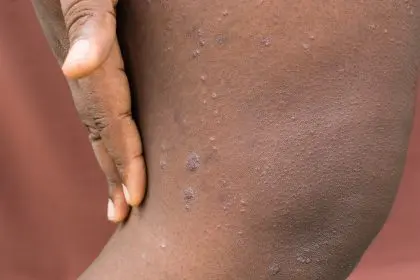The year 2024 has marked a significant turning point in climate-related health discussions, with the Atlantic experiencing 18 named storms, including seven tropical storms and 11 hurricanes. This extraordinary weather pattern, among the costliest hurricane seasons recorded, has brought renewed attention to climate change’s impact on human health, particularly dermatological concerns. The increasing frequency and intensity of these weather events signal a crucial need to understand their implications for skin health. Recent data suggests these patterns are not anomalies but rather indicators of a lasting shift in global weather systems that directly affect human health outcomes.
Dermatological implications
The relationship between environmental changes and skin health has become increasingly evident, according to dermatological experts. Dr. Eva R. Parker of Vanderbilt University emphasizes that skin, as our largest organ, serves as the primary barrier between internal systems and external environmental factors. This protective role makes it particularly vulnerable to climate-sensitive conditions, including various forms of dermatitis, psoriasis, and acne-related disorders. The medical community has observed a notable increase in the prevalence of these conditions, particularly in regions experiencing the most dramatic climate shifts. Dermatologists worldwide report seeing more cases of heat-related skin conditions, with patterns suggesting a direct correlation to rising global temperatures.
Temperature effects on skin conditions
Rising global temperatures create multiple challenges for skin health maintenance. Increased heat levels stimulate excessive sweat production, leading to more frequent pore blockages and subsequent acne outbreaks. The impact extends beyond temporary conditions, as sustained exposure to elevated temperatures can trigger chronic inflammatory responses and accelerate the skin’s aging process, resulting in premature wrinkles and irregular pigmentation patterns. Medical research indicates that prolonged exposure to high temperatures can also compromise the skin’s natural barrier function, making it more susceptible to environmental damage and infection. This deterioration of skin health can lead to a cascade of related health issues, particularly in vulnerable populations.
Scientific foundations
According to National Oceanic and Atmospheric Administration (NOAA) data, global surface temperatures have risen approximately 2 degrees Fahrenheit since pre-industrial times. This warming trend, primarily attributed to increased greenhouse gas emissions from human activities, has significant implications for skin health. The correlation between rising temperatures and heat-related skin conditions particularly affects vulnerable populations, including women experiencing menopause and individuals with pre-existing skin sensitivities. Recent studies have also identified specific molecular mechanisms through which climate change affects skin cell function, providing new insights into the biological basis of these health impacts.
Allergic responses and structural changes
The warming climate has led to increased pollen production, exacerbating allergic skin reactions and eczema outbreaks. Dr. Maria Wei from the University of California, San Francisco, has documented how sustained heat exposure compromises skin structure integrity, potentially accelerating visible aging signs and reducing the skin’s natural protective capabilities. The extended allergy seasons resulting from climate change have created new challenges for individuals with sensitive skin conditions, requiring adaptation of traditional treatment approaches and preventive measures.
Ultraviolet radiation concerns
Climate change’s impact on UV exposure presents another significant concern for skin health. The ongoing recovery of the ozone layer, despite the ban on chlorofluorocarbons (CFCs), continues to leave populations vulnerable to increased UV radiation. This exposure particularly affects UVB rays, known contributors to sunburn development and skin cancer formation. Recent research suggests that changes in atmospheric composition due to climate change may be altering the way UV radiation reaches the Earth’s surface, potentially increasing its harmful effects on skin health even beyond what was previously understood.
Research developments and emerging patterns
Current research indicates strengthening links between climate change and increasing skin cancer rates. While much evidence comes from laboratory studies and computational models, mounting circumstantial data supports the connection between environmental changes and rising global skin cancer incidence rates. New research methodologies, including advanced climate modeling and epidemiological studies, are providing increasingly detailed insights into these relationships. Scientists have identified specific pathways through which climate change affects skin cancer development, including changes in immune system function and DNA repair mechanisms.
Weather-related skin complications
Extreme weather events create additional skin health challenges. Hurricanes and flooding expose populations to contaminated water, increasing infection and rash risks. The psychological stress associated with these events can trigger or worsen inflammatory skin conditions. Conversely, drought conditions often lead to skin barrier dysfunction, raising vulnerability to irritation and infection. The increasing frequency of these extreme weather events has led to the emergence of new patterns in skin disease presentation and has required adaptation of traditional treatment approaches.
Preventive measures and adaptation strategies
Effective skin protection in changing climate conditions requires a comprehensive approach that evolves with our understanding of environmental impacts. Essential preventive measures include regular cleansing with gentle products to remove environmental contaminants while preserving natural skin barriers. During hot weather, lightweight moisturizers help prevent pore blockage while maintaining adequate hydration. Strategic use of barrier products in friction-prone areas reduces rash development risk. Healthcare providers are increasingly emphasizing the importance of personalized skincare routines that take into account individual risk factors and local climate conditions.
Sun protection strategies
Comprehensive sun protection has become increasingly crucial as UV exposure risks rise. This protection extends beyond traditional sunscreen application to include protective clothing and strategic timing of outdoor activities. Understanding local UV index forecasts helps in planning appropriate protective measures.
Environmental awareness
Managing skin health in changing climate conditions requires increased environmental awareness. Air quality monitoring and appropriate indoor air filtration can significantly reduce skin exposure to harmful pollutants. For individuals with chronic skin conditions, maintaining emergency preparedness includes keeping necessary skincare supplies readily available.
Future implications
The intersection of climate change and skin health represents a growing public health concern requiring continued attention and research. As global temperatures continue rising, understanding and adapting to these changes becomes increasingly important for maintaining skin health. This understanding must inform both individual skincare practices and broader public health policies.
Long-term considerations
The effects of climate change on skin health extend beyond immediate impacts, potentially influencing future generations’ dermatological health. This realization emphasizes the importance of both personal protective measures and broader environmental conservation efforts in preserving skin health globally.
















